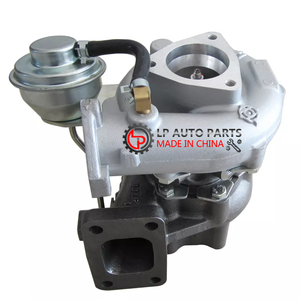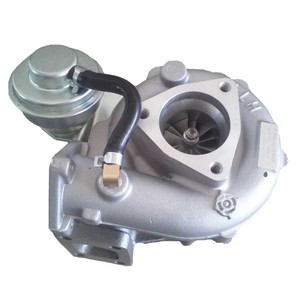(289 products available)





































































































































































































The TD42 turbocharger has become a popular choice for various vehicle engines. Its feature includes a larger airflow capacity and improved engine power output. The turbocharger reduces exhaust emissions. The TD42 turbocharger comes in different types, including:
Single Turbocharger
The single TD42 turbocharger uses a single turbine-compressor unit. The unit draws exhaust gases from the engine and spins the turbine. It compresses the intake air and forces it into the engine. The single turbocharger is lightweight, compact, and low-cost. It is suitable for applications requiring a simple and reliable turbocharging system. The single turbocharger generates a lot of turbo lag. It offers boost at higher engine speeds.
Twin-Turbocharger
The TD42 twin-turbo features two turbochargers. The first turbocharger is for low engine speed, while the second is for high engine speed. This arrangement improves throttle response and reduces turbo lag. The twin-turbocharger design increases power and torque. It allows for a more efficient and broader power band. The TD42 twin-turbo is suitable for performance-oriented applications.
Variable Geometry Turbocharger (VGT)
The variable geometry turbocharger (VGT) is equipped with adjustable blades in the turbine section. The blades improve the efficiency of the turbocharger across various engine speeds. The VGT reduces turbo lag and offers boost at low engine speeds. It optimizes the airflow through the turbocharger. This results in a more responsive and efficient performance. The variable geometry turbocharger is suitable for heavy-duty and commercial vehicles.
Variable Twin Scroll Turbocharger (VNT)
The variable twin-scroll turbocharger combines the features of VGT and twin-scroll designs. It improves the engine's throttle response and reduces turbo lag. The VNT turbocharger is suitable for high-performance applications. It extracts more energy from the exhaust gases. The variable twin-scroll turbocharger increases boost pressure and enhances overall engine performance.
Regular oil changes
Turbochargers need clean oil to operate smoothly. Stick to the recommended oil change schedule for the vehicle. This ensures the turbo gets proper lubrication and avoids damage.
Quality oil matters
Use good oil that meets the vehicle's needs. Look for oil with the correct viscosity and specifications required by the manufacturer. This protects the turbo and other engine parts.
Air filter care
The air filter should be checked regularly. Replace it if worn out or after the recommended mileage. A clean air filter prevents debris from entering the engine and turbo, which could cause wear over time.
Cool down before shutdown
Don't turn off the ignition right after heavy driving. Let the engine idle for a few minutes first. This allows the turbo to cool properly. Sudden shutdowns can lead to overheating issues with the turbo.
Inspect hoses and connections
Hoses carrying air to and from the turbo should be examined periodically. Look for cracks, leaks, or loose fittings. Damaged hoses need replacing right away. Leaks reduce the turbo's efficiency.
Monitor boost pressure
Some vehicles have a gauge for the boost the turbo generates. If the boost seems too high or too low, it indicates a problem. Take the car in to have the turbo checked if the boost isn't normal.
Follow maintenance schedule
All recommended maintenance like fluid changes, filter swaps, and inspections should be done on time. Keeping up with scheduled care helps the entire engine, including the turbo, last longer.
Use quality replacement parts
If the turbo needs any repairs or replacements, use high-quality parts. OEM pieces or reliable aftermarket components ensure the turbo works as intended.
Watch for warning signs
Be alert for any unusual sounds from the turbo, warning lights on the dash, or a drop in engine performance. Early detection of issues allows problems to be fixed before major damage occurs.
Selecting an appropriate TD42 turbocharger for any vehicle requires careful consideration of several factors to ensure compatibility, performance gains, and reliability. Here are some key factors to consider:
Replacing the TD42 turbocharger can be a complex task, but with the right tools, it is achievable. The tools needed are socket set, wrenches, pliers, screwdrivers, torque wrench, hex keys, gasket scraper, new gaskets and seals, engine oil, clean rags, and shop towel. Follow the steps below:
1. Preparation
Ensure that the vehicle is on a flat and level ground, and the engine is turned off and cool.
2. Safety Precautions
Disconnect the battery, wear appropriate safety gear, and follow all safety procedures.
3. Remove Engine Cover
Remove the engine cover. Follow the manufacturer's instructions to gain access to the turbocharger.
4. Disconnect the Turbocharger
Begin by disconnecting the oil lines and coolant lines from the turbocharger using appropriate wrenches and sockets. Be prepared for some oil and coolant spillage and have rags and towels available to clean up the mess. After that, remove the vacuum lines, electrical connectors, and any other hoses or lines connected to the turbocharger.
5. Remove the Turbocharger
Use a wrench or socket set to remove the bolts or nuts securing the turbocharger to the exhaust manifold and downpipe. Carefully lift the turbocharger out of its mounting location and set it aside.
6. Prepare for Installation
Clean the mounting surfaces on the exhaust manifold and engine where the new turbocharger will be installed. Ensure that no debris or old gasket material remains on these surfaces.
7. Install the New Turbocharger
Position the new turbocharger (TD42 turbo) into place on the exhaust manifold and downpipe. Use new gaskets and hardware to secure it, following the manufacturer's torque specifications.
8. Reconnect Everything
Reconnect the oil lines, coolant lines, vacuum lines, electrical connections, and any other hoses or lines that were disconnected earlier. Ensure all connections are secure to prevent leaks.
9. Reassemble
Reinstall the engine cover and any other components that were removed during the turbocharger replacement process.
10. Check and Start the Engine
Check all connections, hoses, and lines for leaks or loose fittings. Ensure everything is properly installed. Start the engine and let it run for a few minutes. Check for any unusual noises, vibrations, or leaks. Monitor the oil and coolant levels to ensure they are within the proper range.
Q1: How can someone know the TD42 turbocharger is faulty?
A1: As highlighted earlier, the turbocharger plays a critical role in enhancing the power and performance of the vehicle. Thus, any problems with the turbocharger will affect the vehicle's performance. As a first sign, users may notice a decline in performance. Other signs include noise, exhaust smoke, the check engine light, and lag.
Q2: What causes the TD42 turbocharger to fail?
A2: Turbocharger failure can be caused by various factors. However, as highlighted earlier, the primary cause is wear and tear. Other causes include improper lubrication, foreign objects, oil contamination, and overheating.
Q3: Can the TD42 turbocharger be repaired?
A3: Yes, the TD42 turbocharger can be repaired. However, it is important to note that repairs may not be very cost-effective, especially if the turbocharger is severely damaged. Additionally, the complexity of the damage determines whether it is feasible to repair the turbo.
Q4: Is the TD42 turbocharger upgrade worth it?
A4: Upgrading to the TD42 turbocharger can be worth it, especially for those seeking more power and efficiency from their vehicles. Nonetheless, the decision to upgrade should be based on the specific needs of the vehicle and the user.
Q5: How long does the TD42 turbocharger last?
A5: The turbocharger is designed to last between 3 to 6 years. However, this lifespan can be affected by several factors such as driving habits, maintenance, and quality.